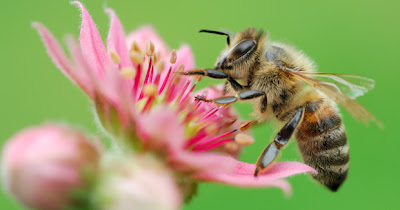Agriculture is the first true beneficiary of the services provided by bees. His contribution in economic terms is really significant to the extent that direct income from beekeeping (honey, wax, pollen and other products) goes to a second term was attempted to estimate this regard in many countries, so for example :
In the United States reflects a ratio of 100 to 1000 times greater benefits to agriculture and direct income hive products.
In Italy you can also consider the importance of bees as pollinators is 60 times greater than the benefits produced by bee products (Giordani 1978).
And in this same country, a pollination experiment kiwi plants in large areas, showed that the honeybee was the insect visitor kiwi flowers and therefore more pollinator, increasing production because the production of fruits large size is required a considerable contribution of pollen from the male flowers of the female to increase the number of pregnancies per flower and consequently also the number of seeds, fruits thus achieving greater than 90 grams.
In France, according to the Bulletin Technique, in 1982, totaled the economic impact of beekeeping on different agricultural crops on which they act, at 53.785 million pesetas in profit. It is reckoned that the bees involved approximately 8 - 100%, depending on the species concerned, in the yield of cultivated plants by insect pollination.
In Spain, crops pollinated by bees under are mainly fruit trees (almond, peach, cherry, plum, apple, pear) forage legumes (alfalfa, clover), cucurbits (melons, cucumbers, pumpkins, zucchini, eggplant) , plants for the extraction of oil (sunflower, rapeseed), textile fibers (flax, cotton), all horticultural crops (strawberries, raspberries, asparagus, blackberries, tomatoes), flowering plants and a newcomer, the vine, are a partial list of plants that depend necessarily or at least favored by the pollination action of bees to the point that it would be much easier to cite the vegetables do not.
It is now indisputable that the bees and beekeepers with them, to a considerable extent involved in agricultural production. Thanks to this role, the private equity beekeepers becomes public property, since the benefit derived from his work is felt throughout the community and thus establishing a reciprocal link between bees, environment, agriculture and man, to be protected.
In the Canaries there is no data, but many of the experiences cited above can be extrapolated to the types of crops on the islands such as tomato, banana, grapes, strawberries, fruit trees, including here the medlar, the avocado and especially greenhouse crops (cucumber, zucchini, cantaloupe, watermelon, etc) which are already being carried out experiments of this type with similar results to those obtained in the peninsula, so that beekeepers and farmers mutual benefit, the beekeeper by renting their hives, they do not collect or honey or pollen, and the farmer increases their yield and quality of them.
In the United States reflects a ratio of 100 to 1000 times greater benefits to agriculture and direct income hive products.
In Italy you can also consider the importance of bees as pollinators is 60 times greater than the benefits produced by bee products (Giordani 1978).
And in this same country, a pollination experiment kiwi plants in large areas, showed that the honeybee was the insect visitor kiwi flowers and therefore more pollinator, increasing production because the production of fruits large size is required a considerable contribution of pollen from the male flowers of the female to increase the number of pregnancies per flower and consequently also the number of seeds, fruits thus achieving greater than 90 grams.
In France, according to the Bulletin Technique, in 1982, totaled the economic impact of beekeeping on different agricultural crops on which they act, at 53.785 million pesetas in profit. It is reckoned that the bees involved approximately 8 - 100%, depending on the species concerned, in the yield of cultivated plants by insect pollination.
In Spain, crops pollinated by bees under are mainly fruit trees (almond, peach, cherry, plum, apple, pear) forage legumes (alfalfa, clover), cucurbits (melons, cucumbers, pumpkins, zucchini, eggplant) , plants for the extraction of oil (sunflower, rapeseed), textile fibers (flax, cotton), all horticultural crops (strawberries, raspberries, asparagus, blackberries, tomatoes), flowering plants and a newcomer, the vine, are a partial list of plants that depend necessarily or at least favored by the pollination action of bees to the point that it would be much easier to cite the vegetables do not.
It is now indisputable that the bees and beekeepers with them, to a considerable extent involved in agricultural production. Thanks to this role, the private equity beekeepers becomes public property, since the benefit derived from his work is felt throughout the community and thus establishing a reciprocal link between bees, environment, agriculture and man, to be protected.
In the Canaries there is no data, but many of the experiences cited above can be extrapolated to the types of crops on the islands such as tomato, banana, grapes, strawberries, fruit trees, including here the medlar, the avocado and especially greenhouse crops (cucumber, zucchini, cantaloupe, watermelon, etc) which are already being carried out experiments of this type with similar results to those obtained in the peninsula, so that beekeepers and farmers mutual benefit, the beekeeper by renting their hives, they do not collect or honey or pollen, and the farmer increases their yield and quality of them.




